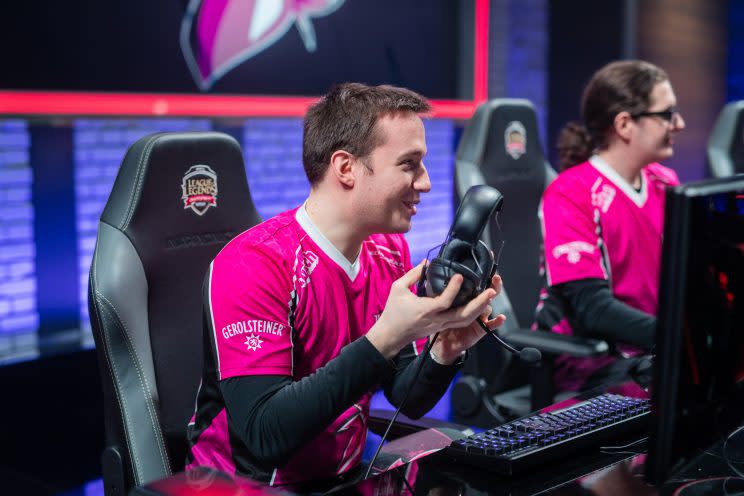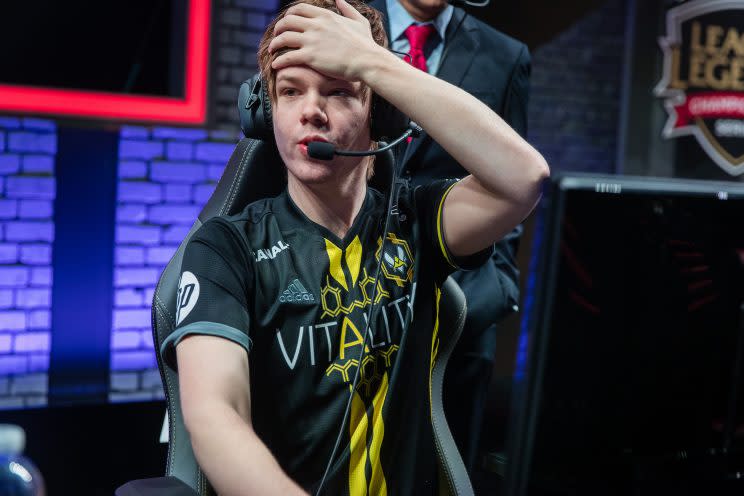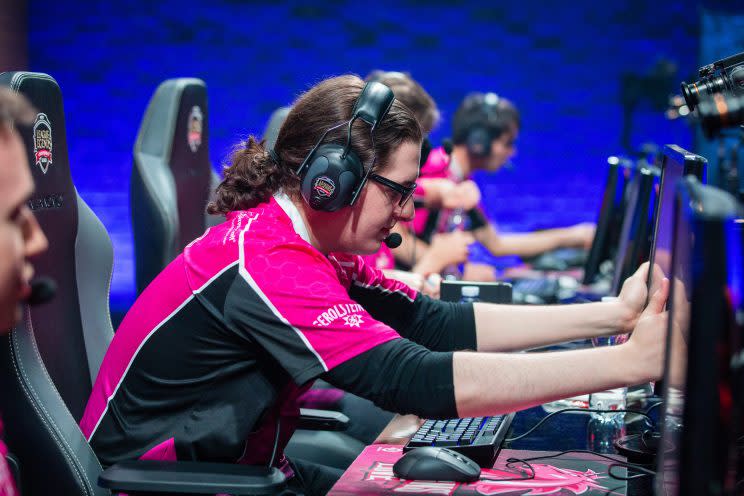The Vitality and The Unicorn: Finding an offseason roster change formula

It didn’t turn out quite like they planned. It never does. Part of the nature of competition comes from an innate need to improve; best one’s self, best the competition. Complete satisfaction is an unattainable end goal. In the wake of the EU LCS semifinals, teams that didn’t pull the results they wanted may scramble for a change in an attempt to finalize a Top 3 Summer Split roster.
Both Splyce and H2K-Gaming, World Championship attendees in 2016, finished outside Top 4 of the EU LCS playoffs. Splyce CEO Marty Strenczewilk said in his YouTube video update, “I don’t think it will come as a surprise to most of you out there that we are internally not happy either — from players to management, I don’t think anyone is happy with our performance.”
In the video, Marty announced that Splyce will part ways with Head Coach Jakob “YamatoCannon” Mebdi, signaling one of the EU LCS’ first offseason changes. Often, when performance suffers, offseason changes can provide a boost to morale or a sense for starting fresh; you won’t blame the same person for the same repeated mistake.
As with anything, there are good and bad ways to handle roster changes between splits. Unicorns of Love this weekend received community praise for a near-constant ability to rebuild, and their position in the final against G2 Esports this split might encourage other organizations to take the plunge in the weeks before Summer.
Name a team other than @UnicornsOfLove that's successfully integrated and succeeded with this many LCS rookies year over year. So impressive
— Noah Whinston (@NWhinston) April 16, 2017
Overlooking Unicorns of Love’s recent rise, one doesn’t have to search very far to see how horribly a midseason gamble can go. Team Vitality, following an unexpected clean sweep at the hands of Fnatic, replaced both their jungler and AD carry between 2016 Spring and 2016 Summer. They went from a Top 3 Spring regular season hopeful to bottom four in both 2016 Summer and 2017 Spring.
Observing what both these teams have done right or wrong can provide the beginnings of an outline on how to handle an offseason overhaul in EU LCS — the Unicorns’ what to do, and Vitality’s what not to do.
First, it’s important to dispel the myth that every rookie Unicorns of Love have touched has turned into a superstar. UoL’s 2016 Summer roster changes left them just inside the playoffs zone, and they benefitted considerably from the elimination of lane swaps on the Playoffs patch. In 2016 Spring, they rifled through a list of junglers that didn’t seem to stick or develop well on the team.
Arguably, UoL’s most successful players developed within the organization itself outside their initial qualifying roster are players on their existing lineup: Fabian “Exileh” Schubert, Andrei “Xerxe” Dragomir, and Samuel “Samux” Fernández Fort. As Xerxe and Samux have only played one split, time will still need to prove whether they can continue to succeed.
UoL’s “rookie development” program may have been overstated. What has consistently worked for them, however, comes through in the strong backbone supplied by Kiss “Vizicsacsi” Tamas and Zdravets “Hylissang” Iliev Galabov.
Unicorns’ increased success came from Vizicsacsi’s steady improvements. Patch changes continued to favor his small trade-focused laning style, and his play made him increasingly reliable. Hylissang’s form has fluctuated more, but his sense for engage and willingness to flank or trade plays has remained true, even when he fumbles. These two pillars not only allowed Unicorns to facilitate communication across the map, but defined Unicorns’ play throughout the years.
At their core, Unicorns’ approach has remained the same.
Strategically, Unicorns have only made small improvements throughout the years. Their vision setup behind and around Baron has improved, but their fixation with the objective has remained a cornerstone that both represents a flaw and a strength. They have made gains in executing 1-3-1 compositions, but more recently have reverted to conservative split-pushing, sometimes indiscriminately stacking side waves, and baiting for a mid lane or Baron pit flank.
When a roster remains constantly in flux like Unicorns of Love’s, sticking to core strategic principles becomes a necessity. If UoL can maintain their current lineup, they might grow and become a more nuanced team. UoL have preserved a foundation in Vizicsacsi and Hylissang, a core strategic playstyle, and the bare bones of their organization. Ideally, they’ll be able to continue to refine the details with a consistent starting five.
When a team decides on a roster change, it is a decision to rebuild rather than refine — to move sideways, not necessarily upwards. Unicorns have done this so many times out of necessity that they came out with a formula that finally got them back to the EU LCS final. But it only worked because they are aware of who they are.

Team Vitality made an extremely drastic overhaul in 2016 Summer. Prior to replacing Ilyas “Shook” Hartsema and Petter “Hjärnan” Freyschuss with Kim “Mightybear” Minsu and Park “Police” Hyeonggi, Team Vitality played to top side, but also relied upon Raymond “kaSing” Tsang to execute catches and maintain vision with Shook. This allowed them to pull off more nuanced compositions designed to counter an opposing team’s playstyle.
Vitality’s flaws were obvious throughout the split, but things like Lucas “Cabochard” Simon-Meslet’s fixable tendency to over-extend went unaddressed. Vitality could have made the choice to focus on fixing resolvable issues in the coming split, but chose two change two players instead.
By Coach Kévin “Shaunz” Ghanbarzadeh’s own admission, the team’s loss to Fnatic was primarily a failure in preparation and the belief that their 1-3-1 approach could no longer work well. Instead of reflecting upon that and moving forward, they chose to believe they had to tear down what they had.
I can’t speak with authority as to why the team decided they couldn’t move forward with their existing roster, but the changes that occurred betrayed that they didn’t understand their own strengths. Shook’s invades relied a lot upon using kaSing to set up vision beforehand, and Hjarnan’s tendency to self-sufficiently shove lane allowed Vitaliy more flexibility in pathing from their support and jungler. This opened up a lot of variety for them to give kaSing freedom and choose a wide variety of niche solo lane picks that addressed opposing team’s core strengths.
Police required more supervision in the 2v2, and Mightybear’s approach varied drastically from Shook’s. He coordinated far less with his lanes and focused more on preparing for neutral objectives. Vitality had to start over with a new identity, and they had no core foundation from which to rebuild.
Other recent roster changes have followed Team Vitality’s unfortunate example. H2K-Gaming’s rise at the 2016 World Championship relied on having both top and bottom lane perform well in strong matchups and transfer the lead to mid. They could take turrets early and efficiently while they juggled pressure across the map.
In their rebuild, H2K replaced their 2v2 bottom lane for a duo they couldn’t consistently rely upon to win with strong lane matchups. Without bottom side pressure, Marcin “Jankos” Jankowski had to tunnel more on ganking for top and mid. Sin “Nuclear” Jeonghyeon and Choi “Chei” Sunho couldn’t get control of the wave and possibly didn’t communicate opportunities to Jankos well.
Then H2K tried to play with more teamfight oriented compositions, but any attempts to improve their weaknesses collapsed without a strong foundation in identity. H2K never bothered to rebuild that.
Several rosters with poor Spring results may look to make a change this offseason. In 2016, Team Vitality picked their lineup apart at its core and had to completely redefine themselves. They still haven’t managed to climb back up the standings two splits later. Obviously poor scouting and disappointing results serve as a cautionary tale to organizations looking to overhaul.
But the lure of Unicorns of Love’s success with two new members this split remains seductive. Before an organization tries to replicate what Unicorns of Love have achieved in a desperate grab to qualify for Worlds this year, they need to fundamentally understand the difference between a Vitality overhaul and a Unicorns rebuild.

Though Unicorns have at least stayed middle of the pack in each subsequent split, one might hardly call each of their rebuilds successful since their debut split saw them enter the final. It was only this split where they really hit a home run, and they did so by constantly nurturing the same foundation.
In keeping the same core, Unicorns didn’t actually have much to rebuild. With Vizicsacsi’s own startling development and an emphasis on maintaining a simple style, they could fill in the holes more simply.
Beyond that, organizations looking to make changes need to understand the players they are hiring. The short break between Spring and Summer doesn’t allow for a lot of tryouts or interviews in hiring new players, which makes importing from another region a foolish and daunting task. You won’t know what kind of player you’re getting unless you’ve at least seen him in your region’s solo queue.
If a team truly feels like improvement can only be achieved by starting anew — and sometimes, that is indeed the best option — they need to at least know what they’re building from. In the coming weeks, checking these principles will mean the difference between bottom four and top three.
You can follow Kelsey Moser on Twitter @karonmoser.

